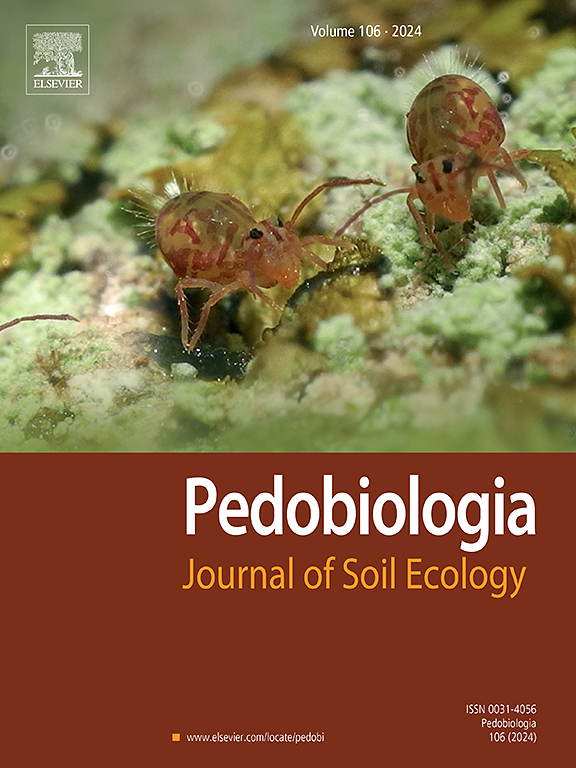森林类型对土壤细菌、真菌和线虫的群落和共生网络模式至关重要
IF 2
3区 农林科学
Q3 ECOLOGY
引用次数: 0
摘要
树木的生长会通过输入不同类型的废弃物和各种根系渗出物来影响土壤的生物、物理和化学特性。然而,我们对树木对土壤生物群组成和多样性的影响的了解仍然有限。本研究旨在确定物理上相邻的森林类型(即人工日本雪松(Cryptomeria japonica)种植园与阔叶(Quercus serrata)次生林)对单个细菌、真菌和线虫群落的影响,以及这些群落之间的关联。利用 MiSeq 高通量测序系统对细菌、真菌和线虫群落进行了估计。结果表明,杉木人工林中真菌和线虫的扩增子序列变异丰富度明显高于阔叶林,三种土壤生物群落结构在不同森林类型中呈显著聚类。土壤 pH 值、C、N 和 C/N 比等环境因素对三种土壤生物群落结构有明显影响。与杉木人工林相比,阔叶林的细菌-真菌-线虫共生网络具有更多的节点和边缘。此外,在雪松林和阔叶林中,子囊菌群和担子菌群真菌分别主要与食菌线虫共生。我们的研究结果表明,在相邻森林类型之间的三方生物群落间关系中建立了独特的土壤生物群落和特征共生网络模式。本文章由计算机程序翻译,如有差异,请以英文原文为准。
Forest types matter for the community and co-occurrence network patterns of soil bacteria, fungi, and nematodes
Tree growth influences the biological, physical, and chemical properties of the soil through the input of different types of litter and various root exudates. However, our understanding of tree-mediated effects on the composition and diversity of soil biota remains limited. This study aimed to determine the effects of physically neighboring forest types (i.e., an artificial Japanese cedar (Cryptomeria japonica) plantation vs. a broadleaf (Quercus serrata) secondary forest) on individual bacterial, fungal, and nematode communities and the associations among these inter-kingdoms. Bacterial, fungal, and nematode aggregates were estimated using MiSeq high-throughput sequencing system. The amplicon sequence variant richness of fungi and nematodes was significantly greater in the cedar plantation than in the broadleaf forest, and the three soil biota community structures were significantly clustered among the forest types. Environmental factors such as soil pH, C, N, and C/N ratio significantly influenced the three soil biota community structures. The bacterial–fungal–nematode co-occurrence network of the broadleaf forest had more nodes and edges than that of the cedar plantation. Moreover, Ascomycota and Basidiomycota fungi mainly co-occurred with fungivorous nematodes in the cedar and broadleaf forests, respectively. Our results suggested that unique soil biota communities and characteristic co-occurrence network patterns were established among the tripartite inter-kingdom relationships between adjacent forest types.
求助全文
通过发布文献求助,成功后即可免费获取论文全文。
去求助
来源期刊

Pedobiologia
环境科学-生态学
CiteScore
4.20
自引率
8.70%
发文量
38
审稿时长
64 days
期刊介绍:
Pedobiologia publishes peer reviewed articles describing original work in the field of soil ecology, which includes the study of soil organisms and their interactions with factors in their biotic and abiotic environments.
Analysis of biological structures, interactions, functions, and processes in soil is fundamental for understanding the dynamical nature of terrestrial ecosystems, a prerequisite for appropriate soil management. The scope of this journal consists of fundamental and applied aspects of soil ecology; key focal points include interactions among organisms in soil, organismal controls on soil processes, causes and consequences of soil biodiversity, and aboveground-belowground interactions.
We publish:
original research that tests clearly defined hypotheses addressing topics of current interest in soil ecology (including studies demonstrating nonsignificant effects);
descriptions of novel methodological approaches, or evaluations of current approaches, that address a clear need in soil ecology research;
innovative syntheses of the soil ecology literature, including metaanalyses, topical in depth reviews and short opinion/perspective pieces, and descriptions of original conceptual frameworks; and
short notes reporting novel observations of ecological significance.
 求助内容:
求助内容: 应助结果提醒方式:
应助结果提醒方式:


